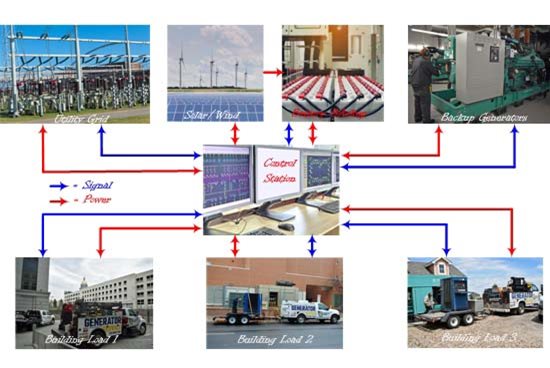
The concept of microgrids has been around for many years. Only recently have they gained significant traction and press as many new projects become a reality and are being put into production. Bloom Energy recently reported 500 new microgrids are in process or becoming deployed as of this year (2019) and worldwide totals are in the multiple GW range.
At the core, a microgrid is a miniature power grid system that is set up to manage distributed energy resources and can include renewables (solar, wind, and/or hydro) with other non-renewable sources (such as diesel generators, gas turbines, etc.). These microgrids typically mange the energy loads of multiple generation systems and also use some type of energy storage system. They work with and manage all of this with different types of software and control systems. They can be set up to operate in parallel with a utility grid and also to run in stand-alone mode during emergencies or based on specific needs.
In this article, we look at the fundamentals of what a microgrid is, how generators play a role in most microgrids, and we also include a short and very helpful video from Schneider Electric that explains these concepts further.
Microgrid Fundamentals - What is a Microgrid?
The U.S. Department of Energy (DOE) defines a microgrid as "A group of interconnected loads and distributed energy resources within clearly defined electrical boundaries that acts as a single controllable entity with respect to the grid. A microgrid can connect and disconnect from the grid to enable it to operate in both grid and island modes".
In addition, the DOE maintains "Microgrids have been identified as a key component of the Smart Grid for improving for improving power reliability and quality, increasing system energy efficiency, and providing the possibility of grid-independence to individual end-user sites". The benefits of using microgrid technology can be:
- Integrates with grid & multiple smart grid technologies
- Integration of distributed and renewable energies, reducing peak load
- Ensures energy is supplied to complexes with critical power needs
Other organizations define microgrids similarly, including the concept of multiple loads and island generation. Island generation is power supplied by wind, solar, hydro generation, or diesel/NG generation.
The illustration in the first graphic is a microgrid that uses utility power as the primary source. The wind and solar farm power a battery bank for emergency use when utility power is lost. Both are normally connected to the grid to lower facility operating costs. When utility power is lost, the complex is switched to battery power from the wind and solar installation. The generators start and assume the load from the batteries. The buildings on the load side of the circuit do not see any power fluctuation because of the design of the distribution grid. When utility power is returned, the load is returned to the utility supply and backup generators are shut down. Wind & solar farm return to normal operation.
Many factors go into the design and construction of a microgrid. Advancements in the power generation and distribution technologies allow for systems that reduce power consumption, use green generation methods, and meet critical power supply requirements. Basic information for each of the power sources and the controls systems is outlined below. The construction of this microgrid is fictional but modeled in concept from DOE projects.
Utility Power & Loads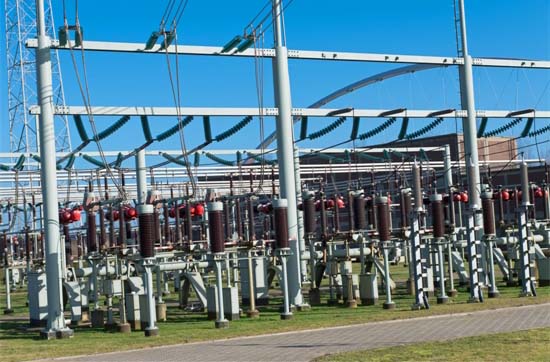
The most common of microgrids use utility power supplied from the local power company as the primary supply. Microgrids located in remote locations can use hydroelectric generation as primary power or employ fossil fuel generating plant as primary power.
Power plants generate high voltage electricity. Some use step-up transformers to increase voltage for transfer to substations. Substations receive voltage from the power plants by high-voltage lines. Voltages are adjusted to requirements and distributed to customers.
Hospitals, state correctional facilities, and data centers are some of the industries that require an Uninterruptible Power Source (UPS). Many have multiple buildings that require constant power. Some of the buildings can have areas that require an isolated power source because of voltage, amperage and/or frequency requirements.
These installations consume a vast amount of power to conduct normal day-to-day operations. They receive power from high voltage lines at a sub-station dedicated to the complex. Voltage is adjusted to desired levels using step-up or step-down transformers. All power is routed through switching and control panels for distribution throughout the buildings.
Each building represents an electrical load. It is possible to have more than one dedicated load to a building. An example of a secondary load point in a building is a frequency converter. One positive voltage peak and one negative voltage peak equal one cycle (Hz). Common supply is 50 Hz or 60 Hz. Some equipment requires a 400 Hz power supply to operate. Frequency converters change 50 Hz or 60 Hz to 400 Hz. There many other examples of secondary load points in a building. In the microgrid design, all are controlled from a single point.
Backup & Peak Demand Generator Power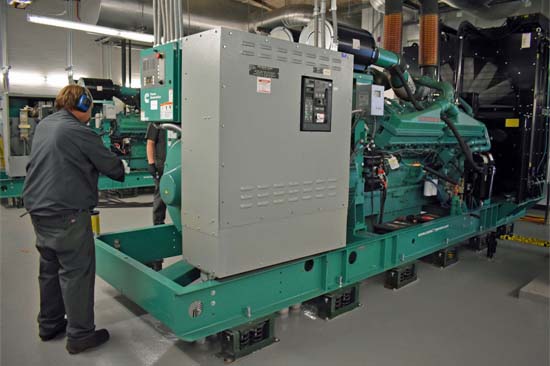
Backup generators supply power to the grid when utility power fails. The generator is comprised of an engine and alternator (generator end). Natural Gas (NG) and diesel-powered engines are the industry standard. NG fueled engines can operate indefinitely as long as utility gas supply is not interrupted. Backup power is not available when the supply is secured.
Generators with diesel fuel engines can operate when all infrastructure fails, including natural gas supply. Main fuel supply tanks must be monitored and replenished when low. Automated systems can notify the operator when tank levels are at a predetermined point to eliminate shut down because of a lack of fuel.
Indoor Generator Applications
Engine, cooling systems, and generator ends are all mounted on a skid fabricated out of steel beams. The skid is mounted to the building floor. Rubber mounts are used in key locations to reduce vibration during operation.
This style generator does not have fuel tanks and requires an external fuel supply. Large primary fuel tank(s) can supply day tanks. They must have building exhaust and supply of cooling air or an aftermarket cooling system such as a Heat Exchanger (HEX) installed.
Outdoor Generator Applications
Generators that are used outdoors are mounted in a weather-resistant or weather-proof enclosure. Many enclosures are sound attenuated to reduce operating noise. The generator is skid mounted on a double wall fuel tank. These generators do not have external fuel, exhaust, or cooling system requirements. Connect output power cables to the generator, and it is ready to assume the load.
Both styles of generators are available with advanced electronic controls and can be operated in parallel. A split backup generator bus can be arranged to supply large amounts of different voltages. To view our stock of new and used generators go to
Generator Source. We provide generator services such as maintenance, troubleshooting & repair, installation.
Green Power Generation
The Environmental Protection Agency (EPA) defines green power as electricity produced from solar, wind, geothermal, biogas, biomass & hydroelectric systems. Our model included wind and solar power. Possible uses are explored below.
Solar Power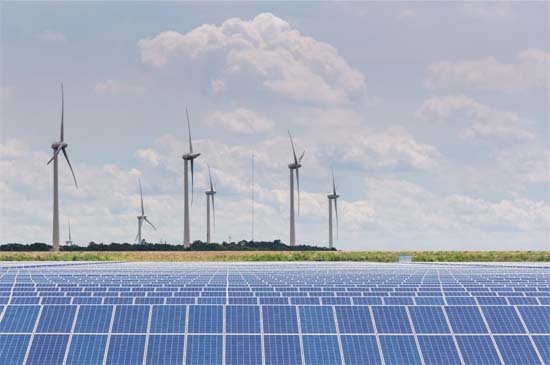
Solar panels are comprised of photovoltaic cells. These cells convert sunlight into Direct Current (DC) electricity. The created electricity is stored in battery banks. Once the battery banks are fully charged, electricity can be routed back using an inverter and sold.
The inverter is the heart of the UPS system. When power is lost batteries supply power to circuits that have critical power requirements. The inverter changes DC to Alternating Current (AC) to supply circuits while backup generators prepare to accept the load.
Wind Power
Wind is used to spin turbines. The turbines produce AC electricity much in the way diesel powered and steam powered generators function. Wind turbines can also be connected to the utility power grid the UPS battery backup grid.
Turbines that are connected to the electrical grid must match the phase and frequency. In order to match phase and frequency of the grid, turbine power is routed through an AC to AC converter. AC is converted to DC then rectified back to AC with an inverter and routed to the grid. The AC current from the wind turbine can also be routed through a converter to aid in battery bank charging.
Solar and wind power are great methods to offset building power consumption costs, but they have not developed enough to accept backup power duties. Both are dependent on localized weather conditions and available battery banks. On a cloudy day without wind battery banks can quickly deplete without charging efforts.
Backup Battery Banks
Green power solutions often employ the use of backup battery banks. These banks provide UPS momentary power only. They are designed to provide power when utility power fails at the facility, while the generators start up to assume the load.
Backup battery systems can be constructed with three different styles of battery banks listed below:
- Lead Acid Cells - Batteries with lead-acid cells are the least expensive solution. These can be a good off-grid answer for smaller applications
- Lithium Ion - Lighter and more compact and last longer than lead acid batteries. However, they are more expensive
- Saltwater - This newcomer relies on elecytrolytes in saltwater. Batteries are mostly untested but easily recycled
Wind powered battery banks are charged by a converter that changes AC to DC. Solar powered batteries do not need a converter because solar panels generate DC. When utility power is lost there is close to a millisecond of time a loss of time for positive generator response.
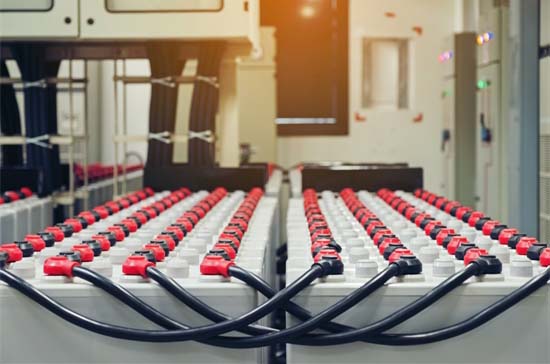
Facilities and complexes such as hospitals, data centers, and municipalities have zero tolerance for loss of power. They rely on banks of batteries to supply power in the interim of a utility power loss. This is a great short-term solution, but battery banks have their limitations.
Batteries with the capability to accept electrical load are expensive for an initial purchase. Lead-acid batteries have electrolyte is the liquid in battery cells. The electrolyte level and specific gravity must be frequently checked. Even with careful maintenance, the lifespan of these batteries can be only 5 to 15 years.
Cost of Renewable Energy & Energy Storage Systems
Renewable energy resources such as wind farms, solar farms, and hydroelectric generation have a large initial purchase price tag. Experienced technicians and construction crews are required to install the purchased equipment. After installation, testing, and commissioning the equipment must be maintained. Often a full-time maintenance force is needed to keep the equipment running to specifications.
Energy storage is rapidly advancing and will be a key player in the future of microgrids. It can be a highly complex subject and requires engineers and planning, and the costs are all over the map depending on your needs. Microgrid Knowledge has an excellent recent article on
some of the latest developments in energy storage from the 2019 conference to dive into here. They detail the path to GW of energy storage goal and latest news from companies and FERC policies now being pushed through.
Control Station
The control station provides the operator with both control and monitoring capabilities. Each system can be divided into a sub-system that has individual pieces of equipment within it.
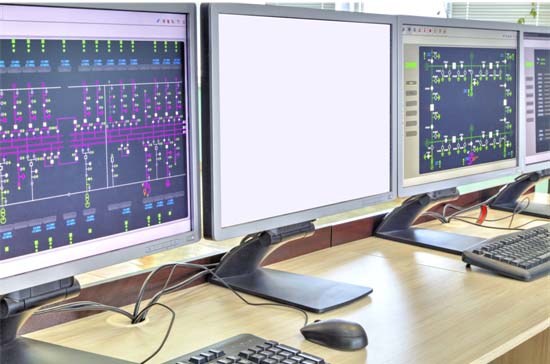
- Distribution and Control Panels - Receive input voltages from all sources and distribute power to needed circuits.
- Backup Generators - Control station software monitors and has the ability to change the generator running configuration to supply power to critical circuits.
- Green Power - UPS battery banks are monitored. Solar power input to battery banks and grid are monitored. Wind turbine stats monitored. The ability to switch to a redundant wind turbine or battery bank.
Basically, the control station provides a software solution to maintain, monitor, and control all of the hardware associated with a microgrid configuration. There can be multiple pieces of software supporting the operations of the grid.
Redundancy is a key principle in the design of these systems. Redundancy is having a ready stand by a piece of equipment in the event of primary equipment failure. Generators, wind turbines, and battery banks are all examples of systems that can have redundant main and supporting equipment.
Some redundant equipment automatically assumes the duties of the assigned main equipment and notifies the operator of an issue. The control station operator then notifies maintenance of the issue so it can be corrected. Redundant equipment meets the same requirements as the main equipment. Often main and redundant equipment are swapped by the operator for scheduled testing.
The microgrid is a concept. It can be as large or as small design as needed for installation. This is an old concept that is here to stay. As power generation technology increases, so will the use of microgrids.
>>Back to Articles & Info<<